 Полная версия
Полная версияThe Dawn of the XIXth Century in England
Brickdust was carried about on donkey back, in small sacks, and retailed at the price of one penny per quart. A contemporary remarks, “As brickdust is scarcely used in London for any other purpose than that of knife cleaning, the criers are not numerous; but they are remarkable for their fondness, and their training, of bull dogs. This predilection they have in common with the lamplighters of the Metropolis.”
The accompanying sketch of a Rat-trap Dealer is graphic and good; and it shows one glimpse of the past, in the old cobbler (?) at his hutch, or low open door. This, or a cellar, always went as an accompaniment to this branch of the shoe-making trade.
To future antiquarians, it may be useful to know that, at the commencement of this century, our domestic animals had their “purveyors of food;” that cat’s, and dog’s meat, consisting of horse flesh, bullock’s livers, and tripe cuttings, were distributed by means of men, or preferably, women, all over London. The horse flesh, and bullock’s liver, was sold by weight at 2d. per lb.; the tripe, in bundles, at 1d. each.
“Baskets” were hawked about – not as we know them (rarer and rarer, year by year) in the gipsy caravans, but slung around the sellers – of good handy size, and durable make. One article of domestic economy has all but died out – the Bellows – and old specimens are almost worth their weight in silver; but the cry of “Bellows to mend!” was then heard commonly. The mender carried his tools in a bag on his back, and, like the chair-mender, plied his calling in front of his patron’s house, or at any convenient street corner.
“Chairs to mend!” might be met with anywhere. Nursery and common chairs, if not having seats of wood, were of rushes, cane being a later introduction. These rushes were, and are now, cut in our rivers, preferably in the early autumn, before they begin to rot, and sold by a peculiar measure – a bolt– which is as much as a man can clasp of rushes, when dried, within his arms. The repairs were executed before the house, and the charge for reseating a chair was very moderate – from 1s. 6d. to 2s. 6d.
“Door mats” were hawked about, as they are sometimes now, but Prisons and Industrial Schools had not then interfered in this trade, so that a poor man had a chance of getting rid of his handiwork, and the price for rush, and rope, mats, varied from 6d. to 4s. each.
If we can believe a contemporary account, the Dustmen of those days were the very pink of propriety. “Dust carts ply the streets through the morning in every part of the metropolis; two men go with each cart, ringing a large bell, and calling Dust O! These men, daily, if necessary, empty the dust bins of all the refuse that is thrown into them. They receive no gratuity from the inhabitants of the houses, the owner of the cart pays them, like other labourers, weekly wages; and the dust is carried to yards in the outskirts of the town, where a number of women and girls are employed in sifting it, and separating the cinders and bones from the ashes, and other refuse.” I much fear that this picture is as couleur de rose as the engraving which accompanies it, wherein the model dustman, with very clean face, is attired in a yellow jacket, green waistcoat, crimson knee-breeches, blue ribbed stockings, and brown gaiters.
The sale of “Turnery” was also a street occupation, and brooms, brushes, sieves, bowls, clothes horses and lines were thus vended. Some, the Aristos of their trade, had a cart; but the perambulating sellers could get a good living, as their wares yielded a good profit.
The Knife-grinder, immortalized by Canning, plied his trade in the sight of the people, and his charges for grinding, and setting, scissors, were a penny or twopence each; penknives, a penny a blade; table knives, 1s. 6d. or 2s. per dozen, according to the polish supplied.
“Lavender” was a cry redolent of the country, yet grown near London, at Mitcham. This was generally used in linen-presses, to counteract the abominably rank smell of the soap of those days. It was a favourite scent; as Isaac Walton says, “I’ll now lead you to an honest ale house, where we shall find a cleanly room, lavender in the windows, and twenty ballads stuck against the wall.”
Among the street cries, was that of “Mackerel”; and the sellers thereof might even expose them for sale, and cry them, on Sundays – a proud privilege which no other fish possessed. There never was a glut of them in the market, because they could only be brought to Billingsgate by smacks, so that they were never sold at the very cheap rates they now are, but were, as we should think, extremely dear. At first coming in they were sold for 1s. 6d. each, and they gradually dropped to 10d., 8d., 6d. each, or, if there was a great haul, three might be sold for a shilling.
might probably bring to remembrance the quotation “Caveat emptor,” but these two purchasers seem quite able to take care of themselves.
It was but a month, or six weeks since, that I saw a sight I had not seen for some years – a man selling Rabbits slung on a pole, which he carried on his shoulder; yet this used to be the usual method of exposing them for sale, and these small dealers were called higglers. The price of Rabbits, thus sold, at the time of which I write, were “from ninepence to eighteenpence each, which is cheaper than they can be bought in the poulterers’ shops.”
shows the universal yearning of the dwellers in town, to make as good a rus in urbe of their surroundings, as possible. The atmosphere of London was then, undoubtedly purer than now, and flowers might then be grown in the open air, where, now, it would be an impossibility.
As an “Old Clothes” man the Jew was then paramount, the Irishman not having, as yet, entered into competition with him. Rosemary Lane (only sweet smelling in its name) was a thoroughfare now called Royal Mint Street leading from Tower Hill; and here was held a Mart, not only in shops, but all over the pavement and road, of old clothes, boots, &c., and it fully merited its name of Rag Fair. A market was built for the buyers and sellers, in which to transact their business; but old habits proved too strong, they would not use it, and “nothing less than military force constantly exercised would prevail over the obstinacy of habit.” The “high” market was from twelve to three.
It was a curious custom then, of course not in good houses, but in those of poor men, such as might be on the outskirts, and in the suburbs of the Metropolis, to strew the floor, say of the kitchen, and sometimes of the parlour, with silver sand. This kept the soles of dirty boots from actual contact with the newly scrubbed boards – and saved the housewife much exercise of temper. Sand, too, was plentifully used in scouring kitchen utensils, and it was sold, the red sand, at 2½d., and the white at 1¼d., per peck.
Fruit, in its season, was cried; and at night, among other employments, by which to earn an honest penny, there were the playbill sellers, and the link boys. The former were almost invariably women, who also sold oranges; and, if a purchaser could be found to go to the extent of buying six, a “Bill of the play” was given. Awful things were those playbills – none of your dainty, lace-edged, Rimmel-scented ones – but long strips of flimsy tissue paper, yet wet from the printers, smearing the hands with ink from the large capital letters employed. No time had they to dry them; there was usually a fresh play every night, and the playbills had to be fresh also.
CHAPTER XXVII
The Postman – His dress – The Post Office – Changes of site – Sir Robert Vyner – Rates of postage and deliveries – Mail coaches – Places of starting and routes – Number of houses in London – Description of them – Their furniture.
ONE PARTICULAR feature of the Streets, was, and still is, one of our most trusted servants, the Postman. In those days he was a somebody, who held personal relations with his clients. None of your rat-tats, and “Look in the letter box”; he generally had something to collect, for there were no postage stamps in those days, and that being the fact, people very often left the postage to be collected at the other end. The officials mounted a hat with a cockade, scarlet coat (the Royal livery), blue breeches, and, of course, white stockings. They used, as in my young days, to collect the letters, nay, in many country districts they do it now.
The location of the Post Office has been changed many times. We are apt to associate it with St. Martin’s-le-Grand, but it was not always so. It was originally in Cloak Lane, near Dowgate, whence it was removed to the Black Swan, in Bishopsgate Street; and, at the time of which we write, it occupied the site of Sir Robert Vyner’s mansion, in Lombard Street: that Sir Robert Vyner, who is historical, if only for his treatment of his king, Charles II. – a story which is well told in No. 462 of the Spectator: “Sir Robert was a very loyal man, and, if you will allow me the expression, very fond of his sovereign; out, what with the joy he felt at heart for the honour done him by his prince, and through the warmth he was in with the continual toasting healths to the Royal Family, his lordship grew a little fond of His Majesty, and entered into a familiarity not altogether so graceful in a public place. The King understood very well how to extricate himself in all kinds of difficulties, and, with a hint to the company to avoid ceremony, stole off and made towards his coach, which stood ready for him in Guildhall Yard. But the Mayor liked his company so well, and was grown so intimate, that he pursued him hastily, and, catching him fast by the hand, cried out with a vehement oath and accent, ‘Sir, you shall stay and take t’other bottle.’ The airy monarch looked kindly at him over his shoulder, and, with a smile, and graceful air, for I saw him at the time, and do now, repeated this line of the old song:
‘He that’s drunk is as great as a king,’and immediately returned back, and complied with his landlord.”
Then, as now, the Lombard Street Post Office was wasted. “It is a national reproach when edifices of this kind, which, from our great mercantile concerns, afford occasion for a display of public architecture, and ornament to the Metropolis, are lost to those purposes.” This was the comment of a contemporary, and the site of the present Post Office in St. Martin’s-le-Grand was not fixed upon or, rather, the first stone was not laid, till May, 1824. As now, the Post Office was always changing its rules and rates – to meet emergencies and keep abreast of the times – so that it would expand this notice to too great a length, were I to chronicle all its changes. Perhaps a short relation of its doings in 1804 – which would be the mean of the decade – will give as good an idea as any other.
“Houses, or boxes, for receiving letters before four o’clock, at the West end of the town, and five o’clock in the City, are open in every part of the Metropolis; after that hour bell-men collect the letters during another hour, receiving a fee of one penny for each letter; but, at the General Post Office, in Lombard Street, letters are received till seven o’clock; after that, till half an hour after seven, a fee of sixpence must be paid; and from half after seven till a quarter before eight, the postage must be paid, as well as the fee of sixpence. Persons, till lately, were, if well known, permitted to have back any letter put in, if required; but, by an order of June, 1802, the masters of receiving houses are not allowed to return letters on any pretence whatever.
“Letters from (? for) the East Indies must be delivered at the India House, where a letter-box is provided for their reception.
“Those for the coast of Africa, or at single settlements in particular parts of the world, may be sent either through the ship letter office, or by the bags which await the sailing of ships, and which are kept at the respective coffee houses near the Royal Exchange.”
We should consider these arrangements somewhat primitive; but then, telegrams and frequent mails have spoilt us. The twopenny post was mainly local, there being six deliveries and collections of letters in town daily, and many country places had two deliveries and collections.
The letters were distributed throughout the length and breadth of the country by means of Mail Coaches, which carried passengers at an average rate of sixpence per mile. This system was inaugurated, and organized, at the latter end of the Eighteenth Century, by a Mr. John Palmer, of Bath, who not only suggested the routes, but to prevent robbery, which, previously, was rife, had every coach accompanied by a well-armed guard, and these coaches accomplished their journeys at a uniform rate, including stoppages, of eight miles an hour. They did not start from the Post Office, but from various inns, and the following is a list of the coaches, and places of starting:
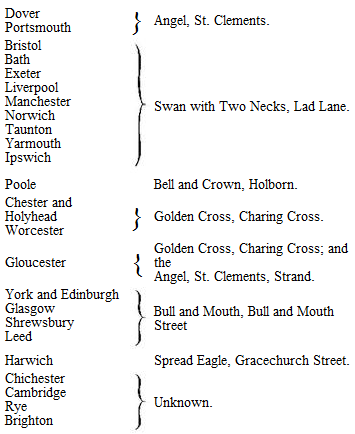
The letters were first of all sorted; then they were weighed, and their proper amount of postage marked on them; they were counted, packed in boxes for the different towns, and an account kept of their number; they were then put in bags, which were sealed, and given in charge of the mail guard. Postage was heavy in those days. Take the charges for 1810:
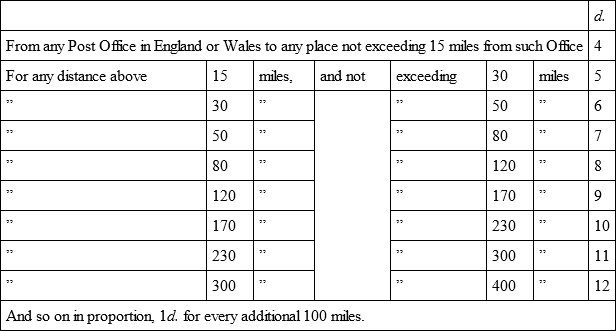
London, at this time, was not beautiful. Apart from the public buildings, its 160,000 houses (the number estimated in 1804) were not lovely to look upon. Utilitarian they were, to a degree – long rows of brick-built tenements, with oblong holes for windows. There was no attempt at architecture: that had gone out with the first George; and, during the first half of this century, domestic architecture in this country was at its lowest possible ebb. Just fancy! in the first decade, Baker Street was considered “perhaps the handsomest street in London.” Can condemnation go further? All the houses were the same pattern, varied only by the height of the rooms, and the number of stories, which were mostly three, and very rarely exceeded four. There was the front parlour, and the back parlour, a wretched narrow passage, or hall, with a flight of stairs leading to the drawing-rooms. In the basement were the kitchen and scullery.
The inside, even, was not redeemed by beautiful furniture. The rich, of course, furnished sumptuously, after their lights – which, at that time, represented anything of classical Greek, or Roman, shape – no matter whether suitable to the purpose for which it was employed, or not. Of course, as now, those lower in the social scale, aped, as far as they could, the tastes of the upper classes; and, as they could not afford the sumptuous gilding, and carving, of the rich, the ordinary furniture of that time was heavy, dull, and dispiriting. Take, for example, the accompanying picture, where, from the style of dress of the ladies, we can but draw one inference – that they were in a good social position. The furniture is dull, and heavy; stiff, high-backed chairs; a table, which would now only be allowed in the nursery; but one candle, and that with a cotton wick, needing snuffing! A tall, narrow, and tasteless mantelpiece frames a poor, starved stove of semi-circular shape, with flat front; the fire-irons stand against the mantelpiece, and a bowed fender, of perforated sheet brass, enclosed the hearth; a small hearth-rug with a fringe, and a bell cord with a plain brass ring, complete the furniture of the room, as far as Gillray depicted it. Not quite our idea of luxurious comfort, yet it was comfort then; tastes were simpler, huge fortunes had not yet been made in manufactures, railway contracting, speculations on the Stock Exchange, or promoting companies – people were more localized (in fact, they could not move), and the intercourse with abroad was very little; and, if it had existed, the hatred of anything foreign, or, especially, French, would have, at once, condemned any innovation.
CHAPTER XXVIII
Food – Statistics as to quantity of meat consumed – Scarcity of fish and game – Supply of latter to London – Venison – A brewer’s dinner – Beer – Quantity brewed – Wine – Its price – Supply of vegetables – Sardines and Harvey’s Sauce – Scarcity of wheat – Forestalling – Rice from India – Bounties given for its shipment.
PEOPLE, then, were conservative with regard to food. For the ordinary Englishman was no appetizing plat, no refinement of cookery – anything out of the usual ruck would be promptly denounced, and fiercely spurned, as French kickshaws. Plain roast and boiled meats were universal, from the highest to the lowest; the quantity of animal food consumed throughout the country was enormous; and, what was more, it was all of home production. No frozen meat, no tinned provisions; the only known way of preserving then, was the time-honoured one of salting. In London alone, according to the very meagre statistics of the day, the number of bullocks slaughtered yearly was 110,000; of sheep and lambs 776,000; calves 210,000; hogs 210,000; sucking pigs, 60,000; besides an unknown quantity of animals of other kinds. This may be an approximate estimate of the number, based, probably, on the quantity sold at the various markets to the butchers, but can give us no idea of the weight, and consequent average consumption per head.
Fish was scarce, and dear; the war, naturally, prevented the fishermen from going far from the coast, and their numbers, moreover, were thinned by impressment. No railways to bring this very perishable commodity quickly to market, no ice to preserve it on its journey; the smack must go to port to unload her cargo, and, being entirely dependent on her sails, was at the mercy of the winds.
Inland, they never knew the taste of salt-water fish, unless some kind friend sent a cod, or turbot, packed in straw, in a basket, as a present by the mail, or stage, coach. Nor could the Londoner, then, get the abundant supply of our salmon rivers, which he now, in common with the whole of England, enjoys.
Game was very scarce, and dear. A country gentleman would not have dared to brave the public opinion of his county, by selling his game, and battues were unknown. The poachers did, undoubtedly, a good trade; and about Christmas time the mail, and stage, coaches came up, loaded with hares, &c. – a fact amusingly chronicled in the Morning Post of the 26th of December, 1807: “The first of the Norwich and Yarmouth coaches arrived at a late hour on Thursday, when, strange to relate, every one of the passengers, inside and outside, were found dead! Not less than four hundred brace of dead game being unloaded from it, for the banqueting of the living Londoners at this luxurious season.” If, however, a story told in the Times of the 20th of January, 1803, is true, it was not always safe to buy game from the coaches: “Saturday night last, an epicure from Fish Street Hill, anxiously watched for the arrival of a Kentish coach, at the King’s Head, in the Borough, in order to purchase a Hare from the coachman, for his Sunday’s dinner; an outside passenger, having learned his errand, brought him under the gateway, and sold him a very large one, as he thought, for nine shillings, which, however, upon his return home, proved to be a badger.”
Poultry was seldom seen except at the tables of the very well to do. The supply was deficient, and they had not the resources we have of railway carriage, and especially of the Continental markets; consequently prices were exorbitant. Venison was considered the dish for an epicure, and was sold – chiefly by pastry cooks – at a reasonable rate: in fact, there were coffee houses where a venison dinner could be obtained for 2s. 6d. Probably the following advertisement indicates a somewhat better style of entertainment —Morning Herald, July 18, 1804: “Venison in perfection. At the Worcester Coffee House, corner of Swallow Street, Oxford Street, Gentlemen may depend on having prime Venison. A Haunch and Neck dressed every day, ready precisely at five o’clock, at the reasonable charge for dinner of 3s. 6d. Wines and Liquors of the finest flavour; best old Port 4s. 6d. per bottle. Venison ready dressed, and pasties sent out. N.B. Fifty brace of good Bucks wanted.”
It was an age of eating and drinking —i. e., men ate and drank in larger quantities than now; but we must not take the following as a typical feast of the time; it was simply a brewer’s dinner, cooked after a brewer’s fashion – yet it was also typical, for then the cult of beefsteak and porter was at its culminating point, and people bowed down, and reverenced them exceedingly. The Morning Post, May 30, 1806: “Alderman Combe’s Annual Dinner. Yesterday, Mr. Combe gave his annual dinner at his brewery, near Long Acre. The party consisted of the Prince of Wales, Duke of Norfolk, Lord Chancellor, Earl of Lauderdale, Lord Robert Spencer, Lord Howick, Sir Gilbert Heathcote, Lord John Townshend, Mr. R. B. Sheridan, Mr. Tierney, Mr. Harvey Combe, and Mr. Alderman Combe. At half an hour past six, the company sat down to dinner. The entertainment consisted of beefsteaks and porter. It was served up in the same style as it was last year. An oaken table, of an oblong form, was set out in the long room of the brewhouse. This table was covered with a large hempen sack, and covers, consisting of wooden trenchers, were laid for each of the guests. The other paraphernalia of the table, namely, the spoons, salt-cellars, salad bowls, &c., were composed of the same material as the plates. The Steaks were cooked by the Stoker, a man so called from his being always employed to keep the fires. This Stoker dressed the Steaks upon a large plate of iron, which was placed in the Copper-hole. When done, the Cook took them out with a pair of tongs, conveyed them into a wooden dish, and, in that style, they were served up. At the expiration of half an hour, the Prince, and the company, retired to Mr. Combe’s house, in Great Russell Street, Bloomsbury, where they partook of a second course, consisting of every delicacy of the season, together with a dessert of fruits, the most rare and abundant we have ever seen. The Madeira, Port, and Claret were the objects of every one’s panegyric.”
Beer was the national beverage, and it was brewed from good malt and hops; not out of sugar, and chemical bedevilments, as at present: and the quantity drunk in London, alone, seems to be enormous. Vide the Annual Register for 1810:
“The Quantity of strong beer brewed by the first twelve houses in the London Porter Brewery, from the 5th of July, 1809, to the 5th of July, 1810.
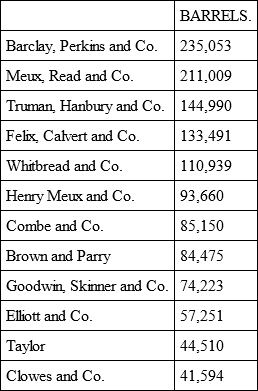
Wines, of course, were drunk by the higher classes, but French wines were comparatively dear, owing to the closing of the trade with France; still there was a very fair quantity captured in the prizes taken at sea, and there was a great deal more smuggled.
Frontignac in 1800 might be bought for 19s. 6d. per doz., and Muscatel at 24s. In 1804, the following are the prices from a respectable wine merchant’s list.
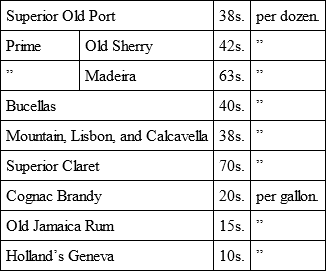
In 1806, Vin de Grave was 66s. per dozen.
For the supply of vegetables, and fruit, large tracts of land were utilized for the supply of London alone. It was reckoned that this city swallowed the produce of 10,000 acres of vegetables, and about 4,000 acres of fruit trees. The market gardens have been gradually disappearing, but they used to be situated principally at Camberwell, Deptford, Fulham, Battersea, Mortlake, Barnes, and Chiswick. This produce found its way to Covent Garden, where the market days were the same as now – Tuesday, Thursday, and Saturday.
During the latter part of the first decade of the century, provisions were not so dear:
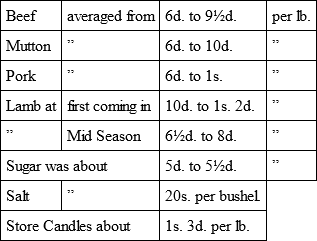
Whilst on the subject of food, I cannot help chronicling the first notices I have ever met with, of two articles familiar to us – Sardines, and Harvey’s Sauce. The first occurs in an advertisement in the Morning Post, August 10, 1801: “Sardinias, a Fish cured in a peculiar manner, are highly esteemed as a Sandwich, and deemed of superior flavour to the Anchovy. Sold,” &c. The second is in the Morning Herald, February 9, 1804: “Harvey’s Sauce for Fish, &c. Black Dog, Bedford. Mr. Harvey respectfully informs the Nobility and Gentry, he has appointed Mrs. Elizabeth Lazenby to prepare and sell the above sauce, at her Oil Warehouse, No. 6, Edward’s Street, Portman Square, and that she, alone, is in possession of the original receipt – signed Peter Harvey.”



